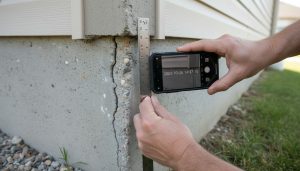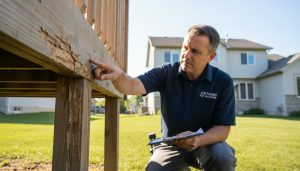How do I check for foundation cracks?
Found a Crack in Your Foundation? How to Check It Fast — Avoid Costly Surprises
Quick answer
If you see cracks in your foundation, act fast. Do a simple inspection: note location, measure width and pattern, look for water or settlement signs, and monitor changes. Small hairline cracks are common. Horizontal or wide cracks, stair-step cracks in brick, or cracks with water are red flags. Call a pro when a crack is wider than ~1/4″ or is actively leaking or shifting.
Why this matters (and why you should care)
Foundation cracks lead to water, mold, and major structural costs. A quick check saves thousands. This short guide gives clear, actionable steps you can do today during a home inspection or walkaround.

Tools you need
- Tape measure or ruler
- Chalk or marker
- Phone camera (timestamp photos)
- Crack monitor or a strip of masking tape for short-term tracking
Step-by-step checklist to check for foundation cracks
- Visual sweep outside: Walk the foundation perimeter. Note cracks in concrete, mortar joints, and brick veneer.
- Note crack pattern:
- Vertical cracks: often from settling.
- Horizontal cracks: structural concern — higher risk.
- Stair-step cracks in brick/block: can indicate wall movement.
- Measure width: Use a ruler or tape. Categories to guide action:
- Hairline (< 1/16″): monitor.
- Small (1/16″–1/4″): monitor and waterproof if needed.
- Large (> 1/4″): get a professional opinion.
- Check interior signs: look for drywall cracks near corners, sticking doors/windows, uneven floors, and water stains in the basement.
- Look for moisture issues: pooling water, poor grading, clogged gutters, or downspouts dumping near the foundation.
- Photograph and timestamp: take close-up and wide shots. Record date and measurements.
- Monitor: mark ends with chalk or tape. Re-check monthly for movement.
When to escalate to a pro
- Crack > 1/4″ wide
- Horizontal cracks
- Active water entry or mold
- Doors/windows that no longer latch or new uneven floors
If any of these occur, call a structural engineer or qualified foundation contractor. They’ll diagnose, recommend underpinning, wall anchors, epoxy injection, or drainage fixes.
Quick prevention tips
- Keep soil grade sloped away from the foundation
- Maintain gutters and downspouts
- Avoid planting large trees close to the house
- Fix leaks and poor drainage immediately

Why trust the advice
Local buyers and sellers rely on expert, direct guidance when a foundation issue appears. For fast, practical help and trusted local resources, contact Tony Sousa — seasoned local realtor who coordinates inspections, engineers, and trusted contractors.
Contact: tony@sousasells.ca | 416-477-2620 | https://www.sousasells.ca
Note: This guide is for quick checking and prioritizing. For a formal diagnosis, hire a licensed structural engineer or certified home inspector.





















